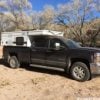
How much solar is too much
#1

Posted 08 May 2015 - 01:41 AM
2015 FWC Hawk
M416 Expedition Trailer
Bayleaf Woof!
#2

Posted 08 May 2015 - 01:54 AM
So...are you asking "How much is enough?" or do you really mean "How much is too much?"
Nothing is too much unless you believe that it's bad for the batteries to keep them topped up most of the time.
I have 240 watts of solar on the roof charging two group 31 deep cycle (wet cell) batteries. I have a 4.5ft3 compressor fridge, which is the biggest draw on the batteries. I haven't had any problems running out of juice with that setup.
Of course, if I was camped in a forest that only permitted an hour of sunlight on the panels, or something like that, more might be needed. But I generally avoid forests...except on the Oregon coast and then I'm plugged into a state park shore power.
FWC Hawk (2005) on a Ford F250 Supercab, 6.8L V10 gas (2000)
#3

Posted 08 May 2015 - 02:36 AM
Can you ever really have enough solar?
I love this question because I really want to answer you can never have enough.
But the real answer is driven by your solar charge controller.
Most of them are rated by amperage.
You probably don't want to exceed the amperage of your solar controller often or you can burn it out.
I would check the controller and see but I would guess that you would likely not have more than 15 amps.
Remember Amps = Watts/Volts
300 watts/14 Volts = 21.4 amps
This would assume ideal, peak conditions and using all of your panels at the same time.
I run 340 watts with MPPT controller that often comes in at 18 Volts.
340 Watts/18 Volts = 18.9 amps
I have a 20 amp MPPT controller and normally would not see more than 17 amps under ideal conditions.
I believe FWC now uses a 160 watt panel and a 15 amp controller.
160 Watts/14 Volts = 11.4 amps
I believe this is why they sized them that way - it is in the operating range of the controller.
I'd check your controller before trying to add a 3rd panel. If you only have a 15 amp controller, you may not be able to handle the
3rd panel without upgrading the controller.
Edited by DrJ, 08 May 2015 - 02:39 AM.
2015 Silverado Crew Cab Duramax and 2015 Front Dinette Grandby
One can change the world, it only requires kindness
http://www.truckcamp...g-family-earth/
#4

Posted 08 May 2015 - 03:13 AM
DrJ's point about the charge controller capacity is a good one: It's certainly true that if your solar panels overwhelm the capacity of the charge controller then that would be "too much".
I bought a new, bigger, charge controller when I went from one panel to two.
FWC Hawk (2005) on a Ford F250 Supercab, 6.8L V10 gas (2000)
#5

Posted 08 May 2015 - 11:56 AM
I am not an expert nor do I have a solar panel/refrig, but my understanding is solar panels are fixed amp devices not fixed voltage like alternators and generators. Panels increase the voltage to force the fixed amps into the system up to a maximum of around 19 volts in full sun and 17 volts on a cloudy day. To keep the math simple, I use a maximum panel output voltage of 20 volts and so each 100 watt panel would be better labeled a 5 amp device in full sun (watts=volts x amps). Clouds would reduce the fixed amp output by half to around 2.5 amps and the panel not facing the sun directly would also reduce the fixed amps below 5. The solar charge controller then drops the voltage and the amps as programmed. If the maximum solar charge controller output voltage is 15 volts then the 100 watt panel can only deliver 15 volts times 5 amps (solar panels are fixed amp devices) or 75 watts to the battery, 25 watts are simply lost at the solar charge controller. Supplying a compressor refrig with enough solar amps is challenging with losses coming from everywhere: the charge controller voltage drop (around 20-25%), clouds (up to 50%), shade (100% loss), the amount the panel faces away from the sun (up to 50%), battery charging/discharging "cost" (around 10%). Meanwhile, you do not want to overload the system with lots of amps when the sun is full and direct on the panels so the solar array maximum amps should be below the rating of every component in the path to the batteries (including the batteries since some have maximum charging rates of 10 amps per battery).
#6

Posted 08 May 2015 - 02:25 PM
The current output of a solar panel -- the amount of amps a panel puts out -- is directly proportional to how much sunlight is falling on it. It's not fixed. It's the panel voltage that is nearly constant.
As a solar panel/system owner with an inline meter can tell you, the current output from the panel increases as the sun rises in the sky.
At dawn, when the sky is light but no significant direct sunlight is falling on the panel, my charge controller light comes on because it "feels" the voltage of the panel. But my Watts Up meter shows that the current is close to zero, with a voltage of 17 - 18 volts (upstream of the controller).
As the sun rises in the sky the voltage (upstream of the controller) stays approximately constant but the current output increases.
Any amount of sunlight produces the same voltage in a solar panel -- it's a function of the physical chemistry of the materials. But in dim light fewer photons are hitting it, fewer electrons are "knocked loose" and so the current -- electron flow -- is less. And when light is brighter -- more photons hitting the cells -- more electrons are "knocked loose" and so current is more.
FWC Hawk (2005) on a Ford F250 Supercab, 6.8L V10 gas (2000)
#7

Posted 08 May 2015 - 03:24 PM
I did some research and found this page of Renogy's website about their 100 watt panels.
http://renogy.com/wp...SED11252014.jpg
The optimum operating voltage for this panel is 17.7 volts.
So our amps = 100 watts/17.7 Volts
This comes out to 5.7 amps which is what their website states as well.
With 2 panels = 11.4 amps
With 3 panels = 17.1 amps
This assumes idea conditions with full sunlight and no shading.
In real life, it would be unlikely to see that much amperage but I guess it's possible.
This is showing a higher voltage than I originally thought on my prior post so the amps are less by that same equation.
My advice is this: check your charge controller. If it's rated for 20 amps there is no problem. If it's rated for 15 amps, you can probably run it with 3 panels but the risk of burning out your charge controller is high. If it's for 10 amps, I wouldn't even try it with all panels.
Hope that answers your question.
2015 Silverado Crew Cab Duramax and 2015 Front Dinette Grandby
One can change the world, it only requires kindness
http://www.truckcamp...g-family-earth/
#8

Posted 08 May 2015 - 03:31 PM
... the risk of burning out your charge controller is high. If it's for 10 amps, I wouldn't even try it with all panels...
Yes -- ask me how I know. ![]()
And THAT'S when I got the higher-capacity charge controller.
(I should have posted the link to my experience last night...but maybe my brain was blocking out the past trauma so I forgot ![]() )
)
FWC Hawk (2005) on a Ford F250 Supercab, 6.8L V10 gas (2000)
#9

#10

Posted 08 May 2015 - 03:51 PM
2015 FWC Hawk
M416 Expedition Trailer
Bayleaf Woof!
0 user(s) are reading this topic
0 members, 0 guests, 0 anonymous users















